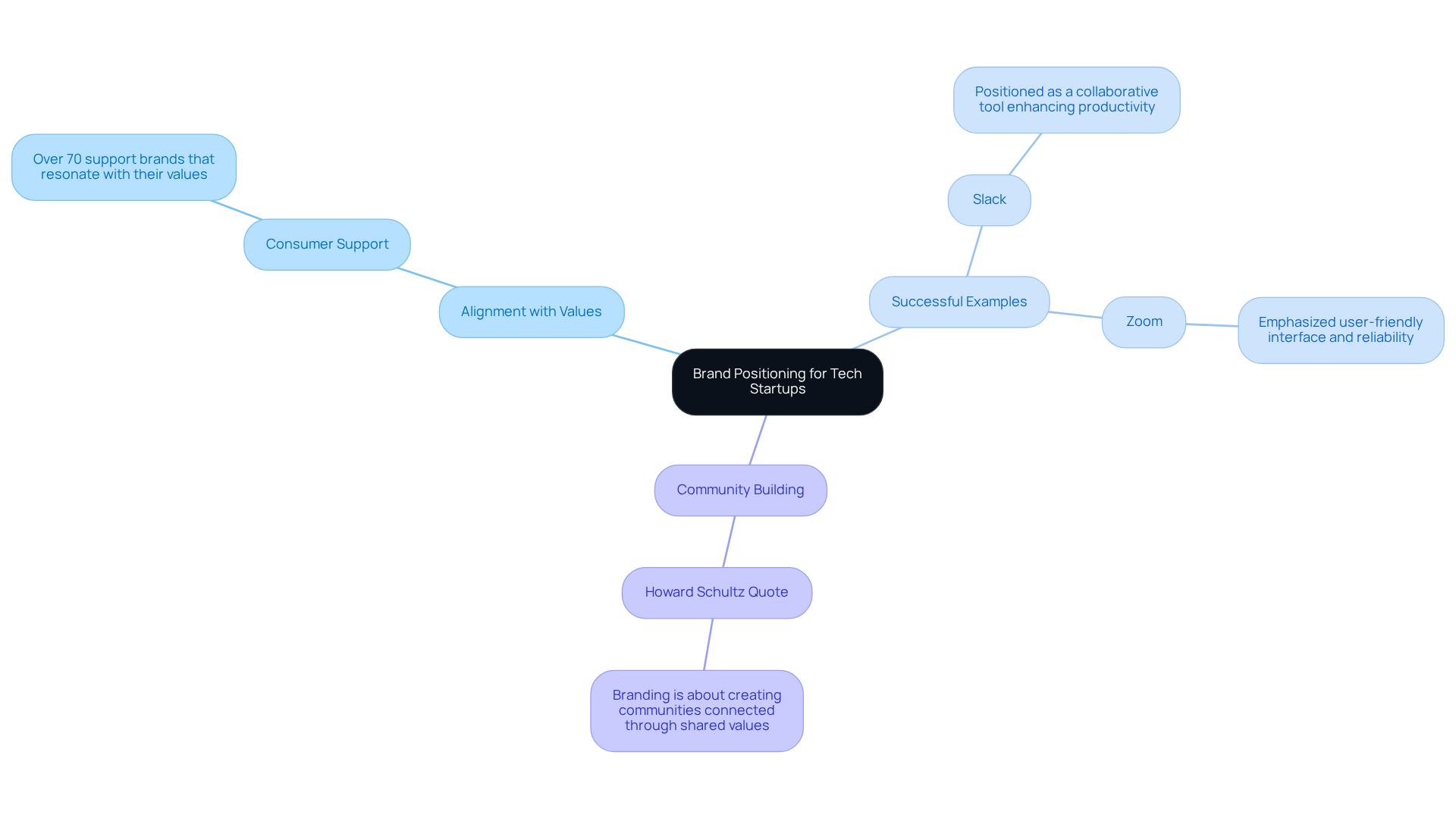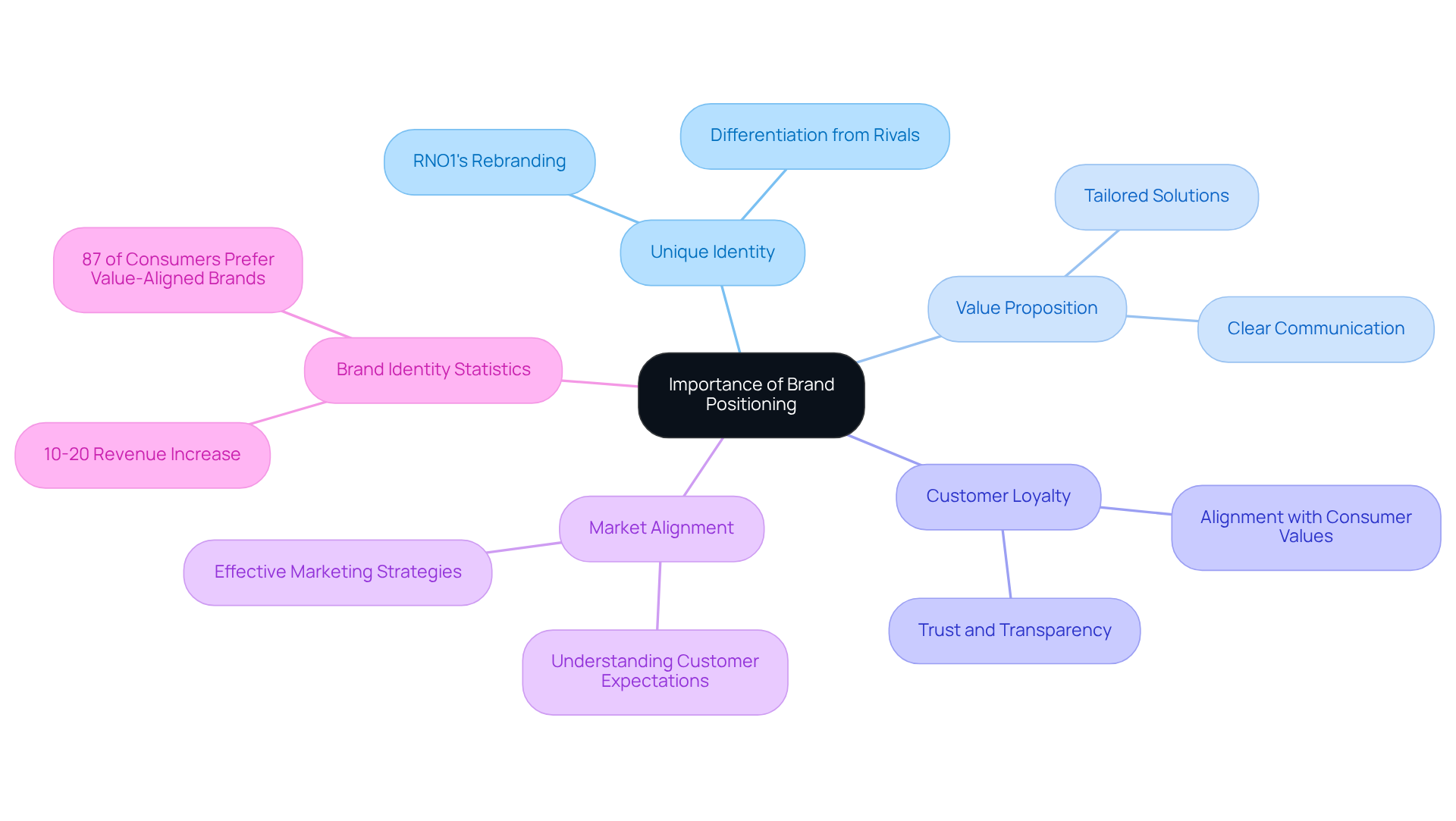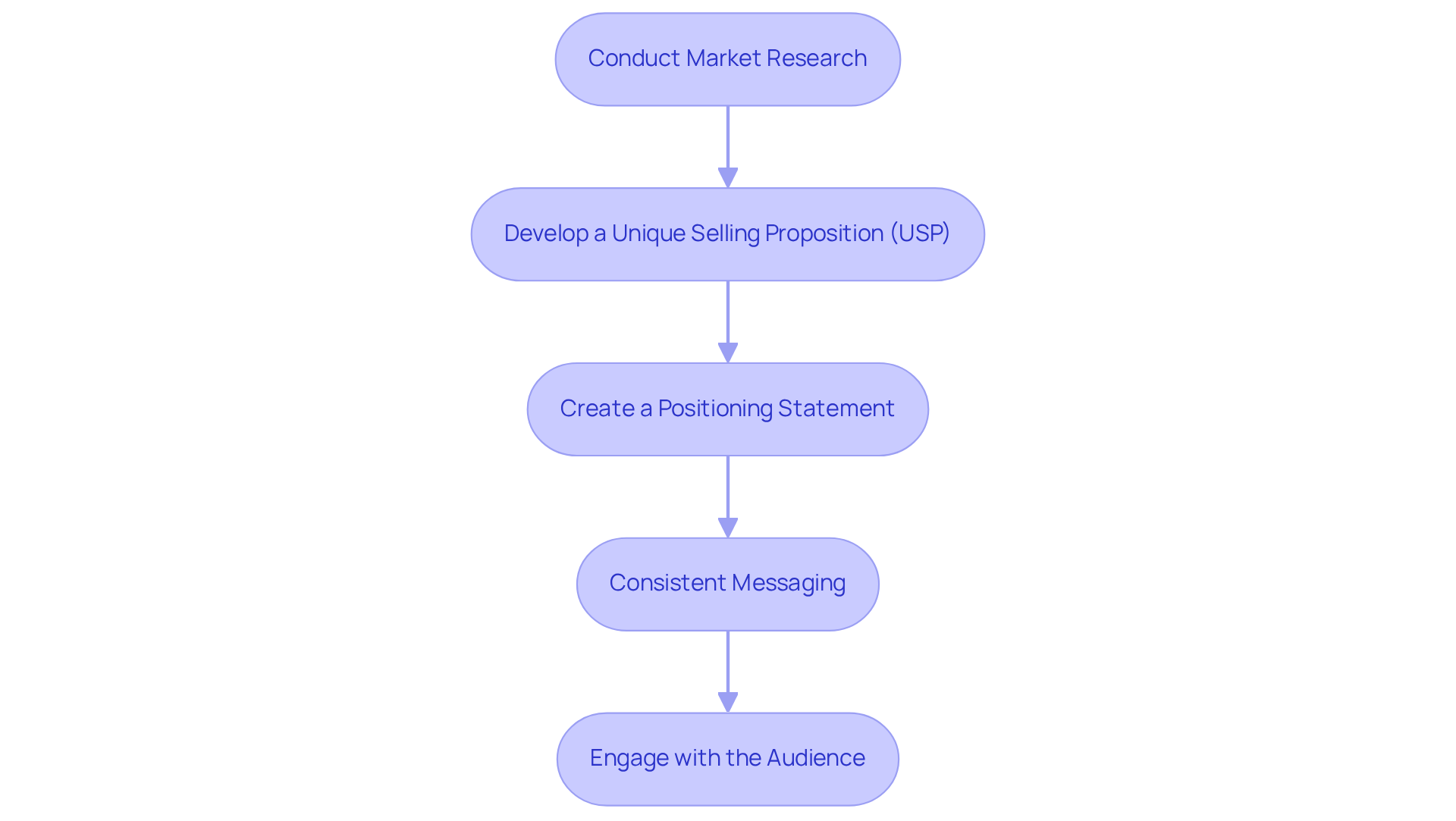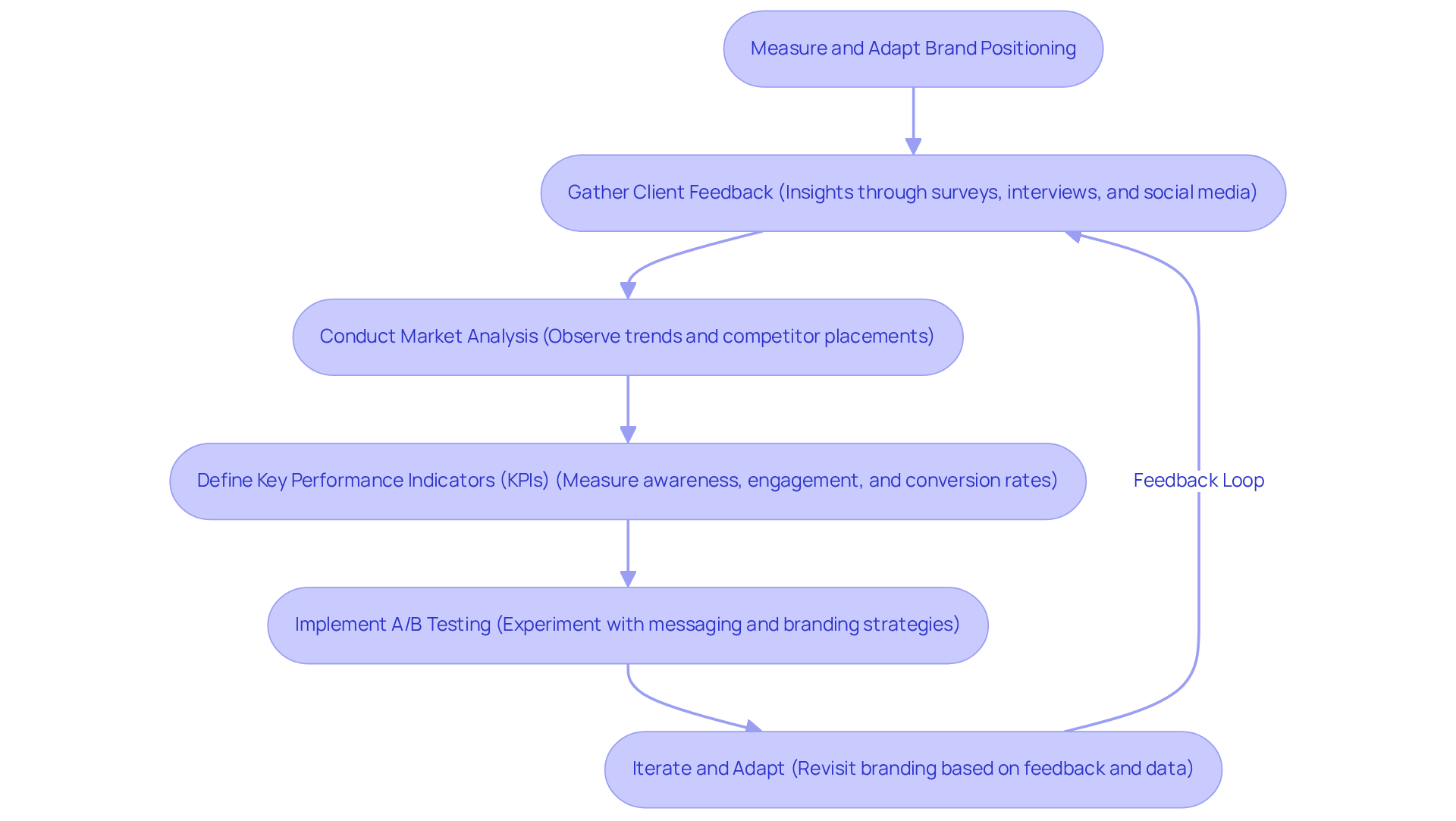Overview
In today's competitive landscape, many tech startups struggle to carve out a distinct identity. This challenge can feel overwhelming, as the pressure to stand out often weighs heavily on founders. Without a clear and unique brand positioning, it becomes increasingly difficult to attract customers and build lasting loyalty.
However, there is hope. By focusing on effective brand positioning strategies, startups can navigate this complex environment with confidence. Essential steps such as:
- Conducting thorough market research
- Developing a compelling unique selling proposition
- Consistently engaging with your audience
are vital. These strategies not only help in attracting customers but also foster a sense of community and loyalty.
Imagine a tech startup that took the time to understand its audience deeply. By listening to their needs and concerns, they crafted a brand identity that resonated with potential customers. This nurturing approach not only distinguished them in the market but also created a loyal customer base that felt valued and understood.
As you embark on this journey, remember that you are not alone. Many founders share similar experiences, and by embracing these strategies, you can build a brand that stands out and thrives. Your unique identity is waiting to be discovered, and with the right support and guidance, you can achieve the success you envision.
Introduction
In the bustling world of tech startups, establishing a unique identity can feel overwhelming. Founders often find themselves wrestling with the challenge of positioning their brands amid intense competition. This struggle is not just a minor hurdle; it carries significant weight. A clearly defined brand positioning is essential—it attracts the right audience, cultivates loyalty, and ultimately drives growth.
Have you ever felt the pressure of making your brand stand out in a digital-first landscape? You're not alone in this journey.
So, what strategies can you, as a startup founder, embrace to ensure your branding resonates with consumers and shines brightly in this crowded marketplace?
Let's explore this together, finding ways to nurture your brand's identity and connect meaningfully with your audience.
Define Brand Positioning for Tech Startups
Brand placement for new technology ventures can often feel overwhelming, as it plays a crucial role in shaping how a brand is perceived in relation to its competitors and within the minds of its target audience. It’s essential to articulate the unique attributes, benefits, and values that your venture brings to the table, all captured in a clear and concise positioning statement. This statement should not only echo your organization’s mission and vision but also address the specific challenges your customers face. For instance, a technology venture focusing on AI solutions might present itself as 'the most for small businesses,' highlighting its commitment to accessibility and ease of use. This clarity in is vital; it not only attracts the right audience but also informs your marketing strategies and product development efforts.
Consider the key elements of :
- Alignment with Values: It’s heartening to note that . This statistic highlights the importance of in nurturing .
- Successful Examples: Companies like Slack and Zoom have shown us the power of . Slack positioned itself as a collaborative tool enhancing productivity, while Zoom emphasized its user-friendly interface and reliability during challenging times.
- Community Building: As Howard Schultz wisely noted, branding is about . This principle is especially relevant for technology companies looking to build lasting relationships with their customers.
At RNO1, we understand that results matter deeply to you; our approach transforms us from mere vendors into collaborative partners in your . By focusing on , we ensure that your identity not only attracts the right audience but also drives effective marketing strategies and product development through positioning branding. Our commitment to design-focused solutions maximizes your market appeal through our Return On Design & Digital (RODD) strategies, ultimately enhancing your venture’s impact in the market. Together, let’s navigate this journey with care and confidence.

Understand the Importance of Brand Positioning
In today's saturated market, technology startups often struggle with their to carve out a unique identity. This challenge can leave founders feeling overwhelmed, as they seek to differentiate their offerings from rivals. However, by effectively conveying a distinct value proposition through positioning branding, new companies can clarify to prospective clients why they should choose their solutions. of Founder's Haven serves as a powerful example of how empowering modern founders can lead to . It showcases innovative solutions tailored for , illustrating the potential for meaningful impact.
is not just about visibility; it nurtures loyalty among clients, ultimately driving increased sales. Consider a startup that positions itself as an eco-friendly alternative in the tech sector. Such a strategy can resonate with environmentally conscious consumers, creating a niche market that feels valued and understood. Moreover, aligns marketing strategies with customer expectations, ensuring that messaging resonates with the target audience.
Research indicates that experience revenue increases ranging from 10% to 20%. This statistic highlights the significance of establishing a through . Additionally, 87% of consumers prefer companies that reflect their values, underscoring the with consumer beliefs to strengthen loyalty and trust.
In a landscape where 4 in 5 job seekers won't apply to a one-star-rated company, having a clearly defined image can positively influence perceptions among potential employees. This, in turn, contributes to a new venture's success. By embracing these principles, founders can foster a supportive environment that not only attracts clients but also builds a community around their brand.

Implement Effective Brand Positioning Strategies
Tech startups often face the daunting challenge of establishing effective for their products. This can feel overwhelming, especially in a . However, by following these essential steps, you can navigate this journey with confidence and clarity.
- Conduct Market Research: Begin by gaining a thorough understanding of the competitive landscape. Identifying market gaps is crucial. This involves while also gathering insights into customer preferences. Remember, successful brands like Airbnb have harnessed these insights to carve out their (USPs), leading to remarkable market disruption.
- Develop a Unique Selling Proposition (USP): It’s important to clearly articulate what sets your startup apart. Whether it's a , an innovative pricing model, or exceptional client service, your USP should resonate deeply with your audience. Research shows that a strong USP can foster , encouraging purchases even at higher prices.
- Create a Positioning Statement: that encapsulates the essence of your company, your target audience, and the unique benefits you offer. For example, saying, 'We provide the fastest cloud storage solution for remote teams,' can speak directly to your audience's needs and aspirations.
- : Ensure that all your marketing materials—from your website to social media—consistently reflect your company's positioning. This consistency fosters recognition and trust among consumers. Look at companies like Apple and Nike; they have effectively woven their USPs into their identity. Additionally, consider using infographics, as they are 30 times more likely to be fully read than text, making them a valuable tool for engaging content.
- Engage with the Audience: Utilize content marketing, social media, and community engagement to strengthen your position and connect with your target audience on a personal level. can significantly enhance this connection. For instance, Vidico's video for Vervoe achieved an impressive 89% completion rate, showcasing how powerful storytelling can be in fostering audience retention and loyalty.
By adhering to these steps, you can effectively implement positioning branding for your technology venture in a competitive market. Remember, it’s about ensuring your identity resonates with consumers and stands out in the digital landscape. You are not alone on this journey; we are here to support you every step of the way.

Measure and Adapt Brand Positioning Success
Tech startups often face the challenge of effectively measuring and adjusting their positioning branding in the market, which can feel overwhelming. Many founders may not realize that in this process. Actively gathering insights through surveys, interviews, and social media interactions can truly illuminate how clients perceive their brand. It’s important to acknowledge that a staggering . Furthermore, nearly 60% of individuals wouldn’t recommend a business with a poorly designed mobile site. These statistics highlight the significance of understanding client sentiment and the pain points that can arise from neglecting it.
In addition to client feedback, . Observing market trends and competitor placements allows startups to identify shifts that may necessitate strategic adjustments. For instance, the tech industry is projected to add , with an annual 356,700 job openings from 2023 to 2033. Staying attuned to these dynamics is essential for navigating the evolving landscape.
Key Performance Indicators (KPIs) also play a critical role in assessing the effectiveness of marketing efforts. By specifying KPIs such as awareness, customer engagement, and conversion rates, startups can quantitatively measure their impact. Websites that prioritize can generate conversion rates up to 400% higher, underscoring the value of these metrics. is vital for informed decision-making, ensuring that startups can pivot as needed.
A/B testing offers another opportunity for growth. By conducting experiments with various messaging and branding strategies, startups can discover what resonates most effectively with their target audience. This based on real-time data. It’s worth noting that even a one-second delay in page load time can lead to a 26% drop in conversions, emphasizing the importance of effective testing.
Finally, it’s crucial to iterate and adapt based on the data gathered. If feedback reveals confusion regarding the brand's offerings, it may be necessary to revisit the positioning branding statement and clarify the messaging. This adaptability is vital in a fast-paced market where consumer expectations evolve rapidly. Remember, you are not alone in this journey; embracing these strategies can empower you to enhance your marketing approach and connect more deeply with your audience.

Conclusion
Establishing effective brand positioning is a critical endeavor for tech startups navigating a competitive landscape. Many founders struggle to articulate a unique identity, which can lead to challenges in attracting their target audience, fostering customer loyalty, and achieving sustainable growth. A well-defined positioning statement not only encapsulates the essence of a brand but also aligns with the values and expectations of consumers, creating a lasting impression in their minds.
Throughout this journey, it’s essential to:
- Understand the competitive market
- Develop a unique selling proposition
- Maintain consistent messaging
- Engage with your audience
Successful examples from companies like Slack and Zoom show how effective positioning can enhance brand visibility and customer loyalty. Additionally, measuring and adapting brand strategies based on client feedback and market trends is crucial, as it allows startups to pivot effectively in response to evolving consumer needs.
Ultimately, the journey of brand positioning for tech startups is not just about standing out; it’s about creating a meaningful connection with consumers. By implementing these strategies, founders can cultivate a brand that resonates deeply with their audience, fostering a community built on shared values and trust. Embracing these principles will not only enhance market appeal but also empower startups to thrive in an increasingly digital world. Remember, you are not alone in this endeavor; together, we can navigate these challenges and build a brand that truly reflects your vision and values.
Frequently Asked Questions
What is brand positioning for tech startups?
Brand positioning for tech startups refers to how a brand is perceived in relation to its competitors and within the minds of its target audience. It involves articulating the unique attributes, benefits, and values of the venture in a clear and concise positioning statement.
Why is a positioning statement important?
A positioning statement is important because it reflects the organization’s mission and vision while addressing the specific challenges faced by customers. It helps attract the right audience and informs marketing strategies and product development efforts.
What are some key elements of effective brand positioning?
Key elements of effective brand positioning include alignment with values, successful examples from other companies, and community building. These elements help nurture customer loyalty and foster lasting relationships.
How does aligning with consumer values impact brand loyalty?
Over 70 percent of global consumers support brands that resonate with their values, highlighting the importance of thoughtful positioning in nurturing customer loyalty.
Can you provide examples of successful brand positioning?
Yes, Slack positioned itself as a collaborative tool that enhances productivity, while Zoom emphasized its user-friendly interface and reliability, especially during challenging times.
What role does community building play in brand positioning?
Community building is crucial in branding as it creates connections through shared values, which is particularly relevant for technology companies aiming to establish lasting relationships with customers.
How does RNO1 approach brand positioning for tech startups?
RNO1 transforms from mere vendors into collaborative partners in digital growth by focusing on measurable success through cross-functional teams. They emphasize design-focused solutions to maximize market appeal and enhance the venture’s impact.




